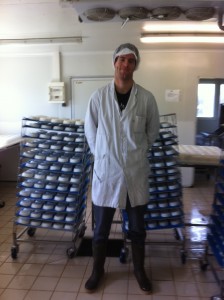DATES: This is a two-day workshop, April 26 and 27th (Saturday and Sunday)
In her 2012 book, Mastering Artisan Cheesemaking (Chelsea Green Publishing) Gianaclis Caldwell explains the art and science that allow milk to be transformed into epicurean masterpieces- with an emphasis on developing intuition through knowledge. Caldwell offers a deep look at the history, science, culture, and art of making artisan cheese as a small-scale creamery. Her first book, The Farmstead Creamery Advisor, (republished in 2014 as The Small Scale Cheese Business) has helped many farmstead cheesemakers get their start. Her most recent book The Small Scale Dairy (also by Chelsea Green) provides similar wisdom for the small raw milk producer.
In this two day session Gianaclis will offer the artisan cheesemaker some hands-on, qualitative and quantitative skills practice for assessing milk’s readiness and appropriatenes, for cheesemaking and environmental practices that effect milk quality. From doing your own standard plate counts and coliform counts, to lacto-fermentation tests; the effect of heat and cold on the availability of calcium and how this affects flocculation; and in house listeria testing prepare to take charge of your cheesemaking in a new way!
Bring an equipment and or milk/brine sample for plate counts, or about 100 ml of fresh, chilled milk in a santized container for a lacto fermentation test. Bring your pH and all other questions as well.
SITE: State of Maine Cheese Co., Rockport
FEE: $175 for Guild Members, $200 for non-members (includes a Guild membership). Registration will be set when deposits are received. Deposits will be refunded for cancellations up to a week before the class begins, after which they are not refundable. If there are more registrations than space available, later registrations will be notified and a waiting list will be started — deposits will be returned for those on the waiting list who cannot be accommodated.
THIS WORKSHOP IS FULL AND HAS A FILLED WAIT LIST; we are looking into the possibility of bringing Ms. Caldwell back to Maine, possibly this fall or next spring, so stay tuned to the Guild web site for an announcement for this.
Maine Cheese Guild
c/o Mark Whitney, Treasurer
Pineland Farms Creamery
92 Creamery Lane
New Gloucester, ME 04260
